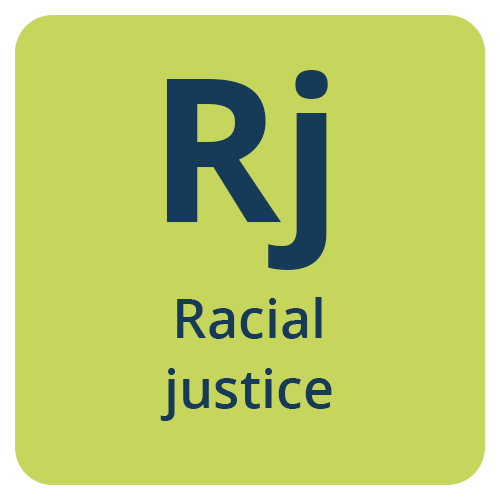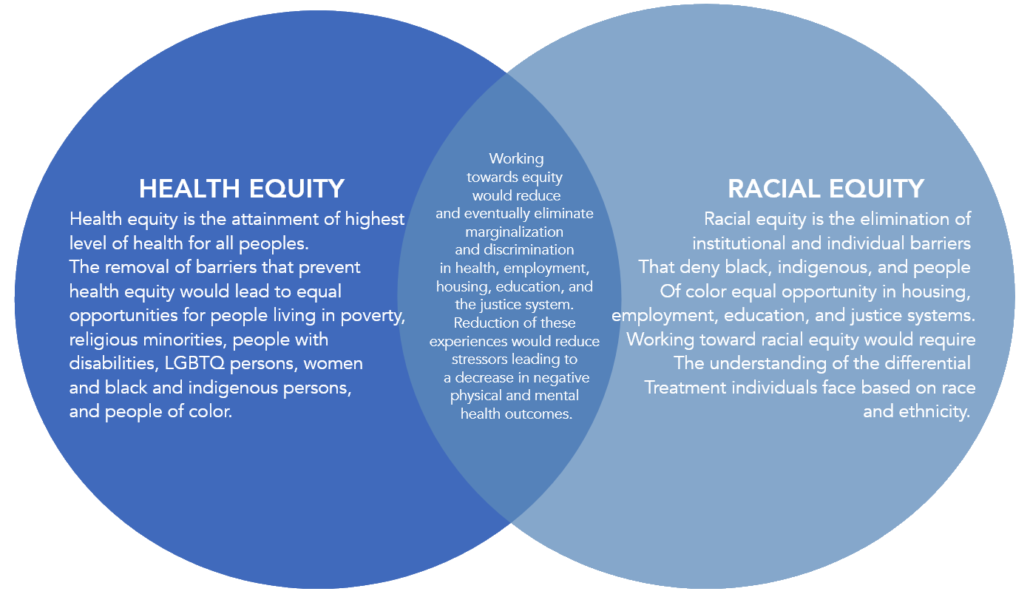
Racial justice extends beyond the absence of disparities, discrimination, or inequity. It includes both equitable opportunities and outcomes, and relies on deliberate systems and supports to achieve and sustain racial equity through proactive and preventative measures.¹
Racial justice is solutions-oriented, but to achieve it there has to be acknowledgment racism exists at the individual or group level, but is not limited to interpersonal actions and that racism is a systemic problem.
- Interpersonal racism is “race-based unfair treatment of a person or group by individuals. Importantly, interpersonal racism does not have to be explicit. The report states that “unconscious bias in interpersonal interactions is strong, widespread, and deeply rooted.”²
- Structural racism (also referred to as institutional racism or systemic racism) is “race-based unfair treatment built into policies, laws, and practices.”²
Recognizing how systems impact people, the American Public Health Association’s past president Camara Phyllis Jones, M.D., PH.D., defines racism as “a system of structuring opportunity and assigning value based on the social interpretation of how one looks (which is what we call ‘race’), that unfairly disadvantages some individuals and communities, unfairly advantages other individuals and communities, and saps the strength of the whole society through the waste of human resources.”³
Part of that ‘waste of human resources’ is, of course, health related. Research shows that racism in all forms has been tied to adverse health outcomes and lower life expectancy among racial minorities.⁴ Unequal access to employment, housing, and education act alongside stressors and trauma from discrimination to impact health outcomes including physical health and behavioral health.⁵
Health equity is inextricably linked to racial justice. Given the role of social determinants like housing, income, and education have in determining health outcomes, and that there are long-standing structural barriers to equity in these areas, changes in health equity necessitates changes in racial equity. Movement toward racial equity will, in turn, affect health equity.
Figure 1. A Venn Diagram of Health Equity and Racial Equity⁶

So, what can a local wellness fund do in their community to work toward racial justice? First, achieving racial equity requires understanding the differential treatment groups receive based on ascribed race and ethnicity. Local wellness funds can seek information both on where differences in health outcomes exist by racial group and where the systemic and structural barriers are to the opportunity to achieve good health. This requires not just data, but involving, understanding, and listening to those whose lives have been impacted by racism. While any level of engagement is better than none at all local wellness funds should become aware of the spectrum of how community voice can be incorporated in their processes.
Secondly, local wellness funds can embed the four pillars of procedural justice. The concept of procedural justice is rooted in the idea of fair processes and has been applied in workplace and criminal justice settings. Evidence shows that when embedded into processes, it promotes positive change and fosters better relationships.
Procedural justice relies on four pillars:⁷
- Respect: All are treated with dignity and respect
- Neutrality: Unbiased, transparent decision-making
- Voice: Opportunities exist for voice in the decision-making process
- Trustworthiness: Decision makers convey trustworthy motives and concern
Embracing Racial Equity: 7 Steps to Advance and Embed Race Equity and Inclusion Within Your Organization
This practice guide from the Annie E. Casey Foundation, recognizes that one way to achieve social change in as an organization to incorporate race equity and inclusion at every stage of work. The seven steps in this action plan provide a clear framework that partners of local wellness funds may find as a good starting point. The practice guide can be coupled with the Annie E. Casey Foundation’s Race Matters: Organizational Self-Assessment, which provides an organizational score for staffing and operational aspects of racial equity. More complementary tools that may be of value to local wellness funds are in the foundation’s Race Matters Collection.
Structural Racism and Health Inequities in the USA: Evidence and Interventions
This article, published in The Lancet, is part of a series called America: Equity and Equality in Health. The authors argue that a focus on structural racism offers a concrete, feasible, and promising approach towards advancing health equity and improving population health. The article provides an introduction to structural racism, documents the health consequences of structural racism, and highlights some promising intersectoral examples of solutions. These examples of transdisciplinary action may be of particular interest to local wellness funds.
Grantmaking with a Racial Justice Lens: A Practical Guide
This report, produced by PRE & GrantCraft, helps funders understand racial justice funding strategies and addresses how to align operational practices to both reduce racial inequity and advance racial justice. Given parallels in grantmaking between local wellness funds and traditional philanthropy, these how-to tips may benefit local wellness funds think about applying racial justice principles to their practice and processes.
Leading Courageous Conversations on Race Equity
Nonprofit New York developed this practical article documenting strategies for organizations to lead honest conversations on race equity. Local wellness funds might incorporate these strategies for creating brave spaces and engaging in courageous conversations helpful as they work to apply a racial justice lens to their work.
- https://www.raceforward.org/sites/default/files/Race%20Reporting%20Guide%20by%20Race%20Forward_V1.1.pdf
- Braveman, P., Arkin, E., Orleans, T., Proctor, D., & Plough, A. L. (2017). What Is Health Equity? And What Difference Does a Definition Make? Robert Wood Johnson Foundation: University of California San Francisco.
- https://www.apha.org/topics-and-issues/health-equity/racism-and-health
- https://www.cdc.gov/healthequity/racism-disparities/impact-of-racism.html
- Paradies Y, Ben J, Denson N, et al. Racism as a determinant of health: a systematic review and meta-analysis. PLoS One. 2015;10(9):e0138511.
Bailey ZD, Krieger N, Agénor M, Graves J, Linos N, Bassett MT. Structural racism and health inequities in the USA: evidence and interventions. Lancet. 2017;389(10077):1453-1463. - Source: LaBoy, A., Lanford, D. (2021). Equity, health equity, and racial equity in the framework for aligning sectors. Georgia Health Policy Center. Retrieved from: https://ghpc.gsu.edu/download/equity-health-equity-and-racial-equity-in-the-framework-for-aligning-sectors/
- https://law.yale.edu/justice-collaboratory/procedural-justice

